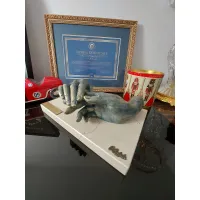Neoclassical sculpture of Circe from the beginning of the 19th century
Luxury antiques
SKU: ANT-A1396
See other products from category Sculptures or from manufacturer Antyki with shipping within 24 hours
Description
Neoclassical sculpture of Circe, early 19th century. The neoclassical figure we propose is a fascinating depiction of the goddess Circe, crafted in the early 19th century. The sculpture, made from Swiss pine wood with an ebonization technique and gilded details, adds value and sophistication to this work. In Greek mythology, Circe is known for her power of transformation and enchantment, and her depiction in an upright position, with arms extended and hands facing downwards in a friendly posture, reflects the dual nature of her character, capable of both love and deceit.
The iconographic representation of the goddess Circe has been depicted in various artistic forms over the centuries – from classical antiquity to modern times; The bronze sculpture by Sir Edgar Bertram Mackennal from 1893 is an excellent example of the reinterpretation of Circe's figure in contemporary art while maintaining traditional iconographic elements. Mackennal, known for his elegant and symbolic sculptures, captures the essence of Circe, highlighting both her beauty and her enchanting power.
Overall, depictions of Circe often included elements such as a chalice, symbolizing her magical potions, and animals, such as pigs, to commemorate her transformations. These iconographic motifs refer to mythological stories, such as those contained in Homer's Odyssey, in which Circe plays a key role. Mackennal's sculpture, though innovative in its approach, fits into a long tradition of representations aimed at conveying Circe's dual aspect: seductive and threatening.
Beautiful antique furniture and accessories can be an excellent idea for furnishing our interiors. Today, there are more and more enthusiasts of high-quality old products that have a specific character and soul. It is a nod to the history, creation, and design of classic and timeless furniture. There are many different styles in antique furniture, each with its distinctive features.
There are many different styles characterizing antique furniture, but we can distinguish a few key ones. Eclectic furniture belongs to the 19th century, during which the Biedermeier style reigned. Its variations in the early years of this century include neo-Gothic, Gothic, Rococo, Louis Philippe style, and finally the English Victorian style. By the end of the century, these styles transitioned into pseudo-styles of classicism, Renaissance, and Baroque.
Beautiful Empire style furniture dates from the period between the late 18th and early 19th centuries. It originated during Napoleon's reign, where significant similarities and references to Roman and Greek decorations were imposed.
Classicist furniture is represented by the Louis XVI style, which also strongly references ancient architecture. Interesting and noteworthy are all antique products in the Rococo and Louis XV styles. Next is the Baroque, whose name comes from the Portuguese 'barocco' – which translates to an irregularly developed pearl. These were very representative pieces of furniture meant to literally ooze glamour and play a significant role in luxury. Exceptional, selectively used materials were employed to further emphasize the lofty tone of these creations.
Today, we can observe how the Baroque style has greatly influenced today's classic furniture, which is designed with a great resemblance to the past era. Another significant style is the Renaissance, which flourished in the 15th and 16th centuries and also left a significant mark on the art of furniture making. The Renaissance style was quite heavy and massive. Brown stains were used, as well as cornices, strong plinths, and bas-reliefs. It can certainly be said that these were quite specific products, but they offered many new possibilities, such as the construction of sideboards or generally broadly defined chest furniture. Here, too, there was an interest in mythology and ancient times, so supports or legs took on animal forms.
Lion's paws, eagle heads – these are common sights in the Renaissance style. Currently, many global brands recreate such crafted furniture, taking examples from Italian or French creators. It is a manifestation of admiration and care for the history of the most beautiful Renaissance antiques. It is important to remember that in each country, furniture making was perceived differently, so each style in a given country had its own distinct character. This is very important, especially when searching for the right luxury antique for your interior.
The most important aspect of stylish antique furniture is originality. This is ultimately crucial from the buyer's perspective, as there are many counterfeits on the market. The Luxury Products brand provides a document confirming the product's compliance with the actual description and photo. We have art appraisers, historians, and experts from around the world at your disposal.
Attributes / Details
| SKU | ANT-A1396 |
| Manufacturer | Antyki |
| Model | A1396 |
| Material | Swiss pine, gold-plated details |
| Size | Height: 71 cm Width: 37 cm Depth: 27 cm |
| Wiek | XIX |
| Rok | 1800 |
| Destiny | To home |
See catalog
Reviews
No reviews for this product.

















